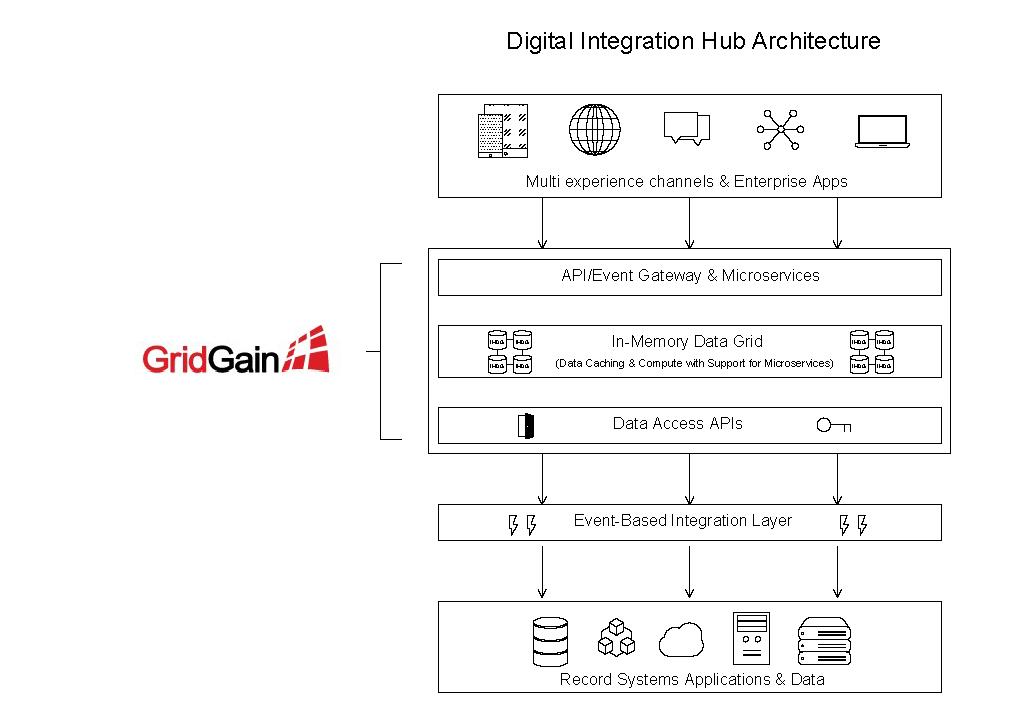What is a Digital Integration Hub?
A digital integration hub (DIH) is an advanced application architecture. It aggregates dispersed data sets in multiple backend record systems into a low latency, high performance, and scale-out data store, without unnecessary complexities. It does this in a cost-effective way.
A DIH supports modern online software applications by providing a decoupled API layer that helps with cloud migration and hybrid deployments. This approach is vital for organizations that must continue leveraging on-premise operational systems, especially when they can’t move sensitive data to the public cloud.
Additionally, DIHs support real-time operational reporting of new data by enabling data integration and analytics for quick and effective big data management.

The Role of High-Performance Data Stores
High-performance computing requires high-performance data storage to keep up with the rapid speed of data growth. A high-performance data store is a vital component of the DIH architecture. The store is a set of networked and clustered computers enabling data sharing among applications running within a cluster by pooling their random-access memory (RAM). Although they offer more than just storage, people describe them as distributed in-memory data stores.
A high-performance data store helps to manage large volumes of structured and unstructured data. It also improves data security and effectiveness. They process complex data in large workloads at millions of input and output operations per second (IOPS).
The high-performance data store significantly improves search speed for unstructured data as it can promptly identify patterns, correlations, and abnormalities in voluminous data sets. It is also a reliable means of storing, preserving, and protecting data sets that grow over time, ensuring that the data is always available on demand. Summarily, the high-performance data store helps to resolve performance and scalability issues in enterprise applications.
Particularly for high-performance computing, multi-tiered storage is not just essential but is also becoming a requirement. Not all the data managed by high-performance data stores is accessed frequently. Companies keep some “just for the records.” As developers, we may need them only occasionally, or, in some cases, we may never use them at all. Therefore, applications that engage in high-performance computing must find a way to optimize storage to accommodate both frequently and infrequently accessed data most cost-effectively.
The high-performance data store, just like many other modern data storage systems, uses a multi-tiered storage strategy for storing various categories of data. It distributes the different categories of data among various storage media (tiers), defined by performance, availability, and costs to optimize data storage. This distribution helps to improve the overall user experience for mission-critical applications.
The most critical data is usually on the in-memory tier, which has the highest performance and speed. This tier typically consists of solid-state drives (SSDs) and Intel Optane memory modules.
Less critical data is on another tier made up of only hard disk drives (HDDs). In some cases, there may also be a third-tier for data archiving, storing data on tapes, or in the cloud.
Applications that use tiered storage can run hybrid queries (operational and analytical) on the records stored in any tiers without compromise, helping manage the total cost of ownership.
Why is a DIH Useful?
A DIH helps accelerate innovation through prompt deployment and launching of modern digital applications and services. Organizations undergoing digital transformation require agile, efficient, and real-time integration of their primary business systems with hybrid cloud deployments. The in-memory DIH comes in handy in this regard, especially when the core business system is a mainframe, as is typically prevalent in mission-critical business operations of financial services and insurance institutions.
These systems create a high volume of essential data that requires synchronization with cloud applications. Conventional architectures do not support modernization because of tight coupling, which increases the effort to modernize each record system since you must make changes to the digital applications accessing them.
Using a DIH, we do not need to worry about data synchronization between the application, cache, and record systems. We can easily access all critical data in a central, high-performance data management layer using modern protocols. By decoupling API services from record systems, the DIH increases throughput, reduces latency, and ensures constant application availability.
Real World Use Cases
Because of DIH performance and flexibility, organizations use it for a wide range of applications.
Sensor Data Integration
Today, many organizations gather data using sensors. The challenge is integrating this data with data from other sources. Sensor data drives real-time processes that require frequent API calls each time. A DIH helps cache data efficiently for fast processing.
Technology Scaling
A DIH helps organizations that deal with petabytes of data to scale quickly without inhibiting performance. This efficient scaling makes the digital transformation process seamless.
Big Data Management
A DIH improves big data management efficiency by enabling data integration and analytics. It also provides real-time reporting of new data in industry operations.
API call management and call reduction also use a DIH. The DIH creates shared data access layers that allow many enterprise applications to access data from various databases. It also enables real-time analytics spanning operational and historical data.
GridGain as Digital Integration Hub
GridGain is a robust, SQL-based, in-memory computing platform that has proven to be a valuable solution for a wide range of industry applications, from retail businesses to financial services and insurance. This in-memory computing platform built on Apache Ignite is a critical component of GridGain’s DIH.
It’s used as the high-performance store that keeps data from many underlying data stores, including SaaS applications, databases, and incoming data streams. It also has an API services layer that automatically synchronizes data, capturing changes in backend sources. This way, enterprise applications don’t need to make direct API calls to each data store.
These videos on IBM and Z Digital Integration Hub and 24 Hour Fitness provide more insight into some of GridGain’s DIH applications.
Conclusion
Today’s world is data-driven. The business climate is fast-paced and dynamic. And, modern technology requires plenty of mobility, speed, and flexibility.
To keep up with all these concerns, we need a standard DIH to help promptly and seamlessly integrate new applications into our stacks to work with our legacy data. Depending on the data processing platform’s existing architecture, a DIH may be the best solution to help with digital transformation initiatives.
To learn more about DIHs, download the application note Powering Your Digital Transformation with a Digital Integration Hub and see how IBM uses GridGain as a core component of the Z Digital Integration Hub.
If you’re interested in developing expert technical content that performs, let’s have a conversation today.




